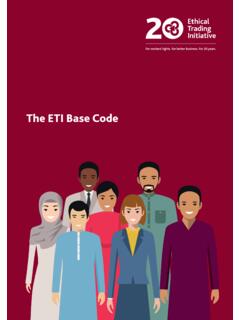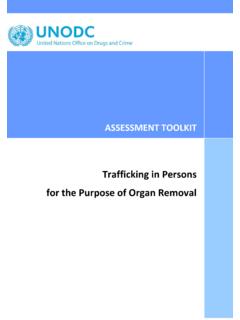Transcription of HUMAN RIGHTS DUE DILIGENCE FRAMEWORK - Ethical trade
1 1 HUMAN RIGHTS DUE DILIGENCE FRAMEWORK HUMAN RIGHTS Due DILIGENCE Framework1 Introduction 2A fresh approach 4 The purpose of this FRAMEWORK 4 What is HUMAN RIGHTS due DILIGENCE ? 5 ETI Base Code 6 Workers at greatest risk of HUMAN RIGHTS abuses 7 High risk factors & sector-specific risks 8 Key principles for meaningful due DILIGENCE 9 ETI HUMAN RIGHTS due DILIGENCE FRAMEWORK 101. Assess actual and potential HUMAN RIGHTS risks 122. Identify leverage, responsibility and actions to be taken 133. Mitigate risk and remediate workers 144. Monitor, review, report and improve 15 Annex 1: Legal requirements on HUMAN RIGHTS due DILIGENCE 16 Annex 2: Engaging with stakeholders 17 Annex 3: Sector-specific rrisks 18 Annex 4: Conducting a detailed inquiry 19 Annex 5: Reviewing the business model 20 Annex 6: Monitoring and review 23 Annex 7: Case study Describing a HUMAN RIGHTS risk 24 Annex 8: Further information and resources 25 CONTENTSA guide for companies to help them prevent and manage labour RIGHTS risks, and understand why engagement, negotiation and collaboration is the only way to succeed.
2 Photos: ETI, ILO HUMAN RIGHTS Due DILIGENCE Framework23 Businesses operate in an increasingly complex environment. This is fundamentally affecting the way decisions are made on the use of resources, time, and people in a company. Risk assessments and due DILIGENCE have always been part of corporate practice to assure the quality, profitability and reputation of businesses. But respect for HUMAN RIGHTS is a relatively new feature for corporate due DILIGENCE policies and practices in their own operations and supply chains. These are driven by the UN Guiding Principles on Business and HUMAN RIGHTS and new legislation on modern slavery. See Annex 1. Legal requirements on HUMAN RIGHTS due FRAMEWORK is concerned with the way that business impacts on the HUMAN RIGHTS of those who are employed within global supply chains.
3 When we use the terms labour RIGHTS or workers RIGHTS in this document, we are referring to the HUMAN RIGHTS of workers. Effective corporate HUMAN RIGHTS due DILIGENCE is not only a legal requirement, but is also good for business: there is ample evidence that responsible businesses have better visibility of their supply chains; they have more secure supply of goods and services because they face less labour unrest, staff turnover, hiring and training costs; they are more productive because workers are more engaged, better trained and happier at work, and their reputation and credibility is far better with customers, investors and suppliers. Governments play a critical role in creating an enabling environment for companies to operate.
4 Where national and local governments display a lack of political will, capacity or responsibility to protect HUMAN RIGHTS , it is difficult for companies to act responsibly and prevent HUMAN RIGHTS violations. This raises questions about the choices that companies make in where they invest and source their goods and services, whether their suppliers have the capacity to meet the companies expectations, and whether suppliers are able or willing to comply with risk management systems. Civil society, consumers, investors and trade unions are increasingly challenging companies and governments, and are publicly calling on them to account for their responsibilities and actions to prevent, manage and mitigate labour RIGHTS violations.
5 INTRODUCTION Responsible businesses have better visibility of their supply chains; they are more productive because workers are more engaged, better trained and happier at work, and their reputation and credibility is far better with customers, investors and suppliers. HUMAN RIGHTS Due DILIGENCE FRAMEWORK HUMAN RIGHTS Due DILIGENCE Framework45 Most companies continue to rely on audits and compliance-based approaches to manage and mitigate HUMAN RIGHTS risks even where they recognise the limitations of these approaches. They simply can t imagine another way of doing it especially in light of constrained resources, skills and increasingly competitive markets. This means they out-source and delegate the management of risk to their suppliers, auditors and other expert organisations to tell them what they need to know and what they need to do.
6 This weakens the relationship of companies with their suppliers and can reduce their sense of ownership of and responsibility for the potential HUMAN RIGHTS risks. ETI s tripartite approach brings companies, trade unions and NGOs together to shape the due DILIGENCE agenda and to ensure the most important risks for workers RIGHTS are identified and addressed effectively at each level of the supply chain. Whilst the focus of this FRAMEWORK is on labour RIGHTS , it can be used alongside other guidance and tools that include environmental and community based HUMAN RIGHTS impacts. It is closely aligned with the ETI Base Code and Principles of Implementation, the UN Guiding Principles on Business and HUMAN RIGHTS , OECD Due DILIGENCE guidance tools, and the SHIFT RAFI FRAMEWORK , amongst others.
7 This FRAMEWORK should also help companies meet their legal obligations to report on the steps they are taking to tackle modern slavery, forced labour and HUMAN trafficking. Companies with operations in the UK, USA, Brazil and elsewhere, can be held criminally liable for committing modern slavery offences, and the penalties can be FRESH APPROACHTHE PURPOSE OF THIS FRAMEWORK WHAT IS HUMAN RIGHTS DUE DILIGENCE ? HUMAN RIGHTS due DILIGENCE is the action taken by a company to both identify and act upon actual and potential risks for workers in its operations, supply chains and the services it uses. ETI s approach to HUMAN RIGHTS due DILIGENCE is based on multi-stakeholder engagement and processes that include: Assessment of actual and potential HUMAN RIGHTS risks Mitigation of risk and remediation for workers impacted by HUMAN RIGHTS violations Identification of corporate leverage and responsibility, decision-making and actions needed Monitoring, review, reporting and continuous improvement ETI s experience has demonstrated that this is the most effective form of due DILIGENCE and the most likely way to bring about lasting change.
8 HUMAN RIGHTS Due DILIGENCE FrameworkETI s approach is different. It offers companies a fresh approach to help them to manage and mitigate risks more effectively not through audits and out-sourcing of due DILIGENCE assessments, but through: Better risk assessment and detailed analysis of HUMAN RIGHTS risks, impacts and causes Better internal reviews of approaches, policies and practices (looking in the mirror) to identify which of these directly or indirectly contributes to HUMAN RIGHTS risks Effective stakeholder engagement within the company, with other companies, with suppliers, with trade unions, government agencies, civil society organisations, experts and multi-stakeholder initiatives.
9 This will lead to far more effective (and cheaper) solutions in the long termSee Annex 2: Engaging with stakeholdersThis tool will help companies to meet their corporate responsibilities to respect HUMAN RIGHTS in the labour RIGHTS context, and report against these obligations. It sets out the critical elements of HUMAN RIGHTS due DILIGENCE and how they relate to one another. It will help companies understand what information is needed to make the right kinds of decisions, who to engage and why. HUMAN RIGHTS Due DILIGENCE Framework7 WORKERS AT GREATEST RISK OF HUMAN RIGHTS ABUSESMARGINALISED GROUPS SUBJECT TO DISCRIMINATORY LAWS AND TREATMENTCHILDRENWOMENSEASONAL WORKERS SUCH AS AGRICULTURAL WORKERS CONTRACT AND AGENCY WORKERS DOMESTIC workers migrant workers INTERNAL AND CROSS BORDERETI BASE CODEE mployment is freely chosen*Working conditions are safe and hygienicFreedom of association and the right to collective bargaining are respected*Living wages are paidNo discrimination is practised*No harsh or inhumane treatment is allowedChild labour shall not be used*Working hours are not excessive*Regular employment is providedThe ETI Base Code covers the major areas of HUMAN
10 RIGHTS risk for workers in global supply chains: HUMAN RIGHTS due DILIGENCE must include a focus on the most vulnerable workers, these include: See also Annex 3: Sector-specific risks.*Internationally agreed core HUMAN RIGHTS . All UN member states, whether or not they have ratified the relevant ILO conventions, are obliged to meet these labour standards. 6 HUMAN RIGHTS Due DILIGENCE FRAMEWORK HUMAN RIGHTS Due DILIGENCE Framework89In company operations and global supply chains, some of the most significant risk factors include: Lack of government protection of labour RIGHTS (poor laws, regulations, undemocratic states) Use of sub-contractors and agencies (risks for visibility of supply chain and indirect employment) Lack of government labour inspection and monitoring (capacity, resources, political will) Reliance on audits (credibility of data and reliability of evidence of risk) Complex production processes in a single product sourced from multiple sites Labour market dynamics (high unemployment and poverty rates, state fragility and conflict) Unscrupulous recruitment practices (debt bondage for workers due to high fees by recruiters)


